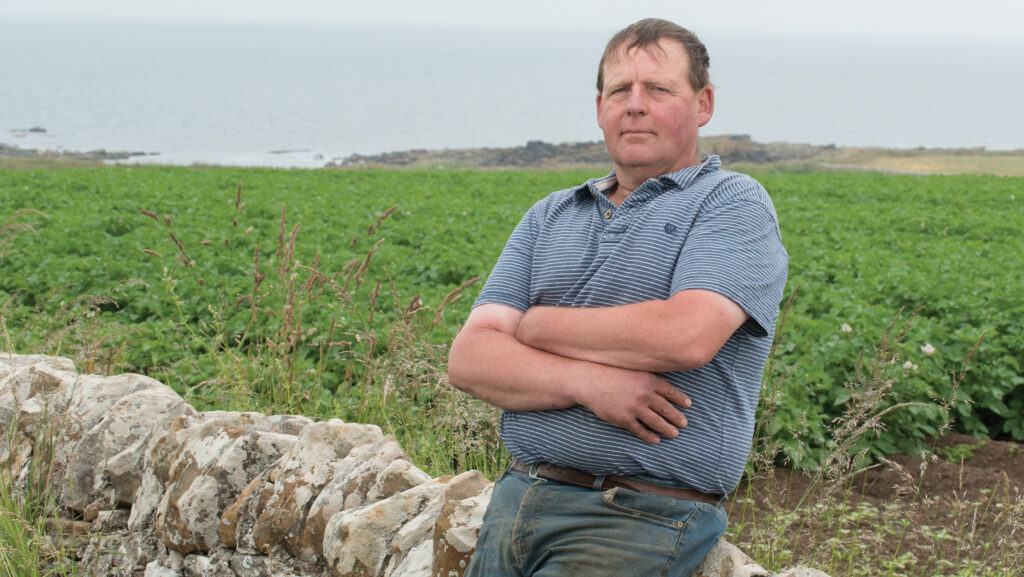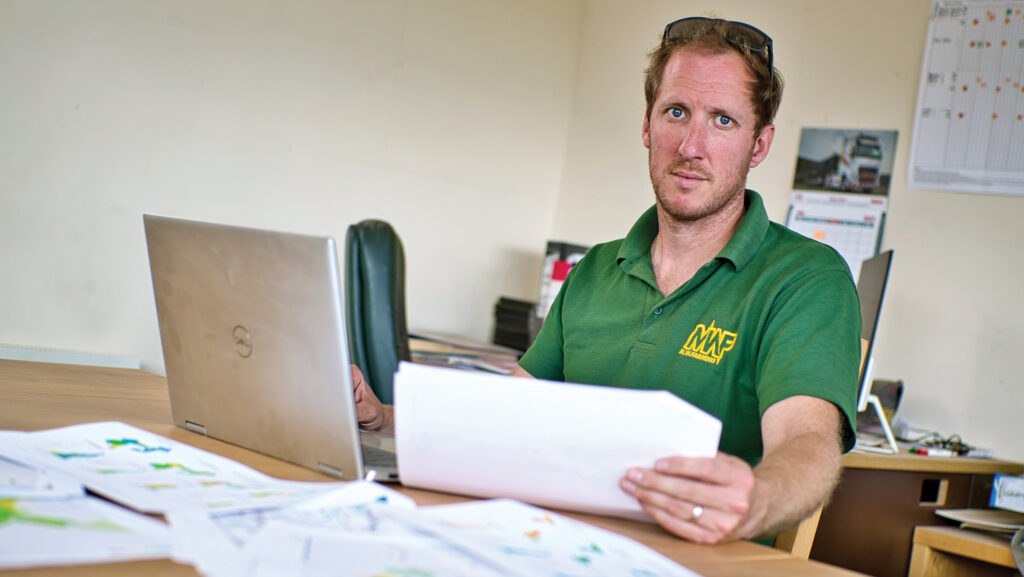Unpredictable weather hampers Transition Farmers’ aims
 © GNP
© GNP Heavy rainfall and more extreme weather have seen Transition Farmers adjust their cropping plans.
We catch up with Transition Farmers Alan Steven in Fife and Matthew Williams in Shropshire to find out how they are employing mitigation and risk reduction strategies.
See also: How low-input spring cereals SFI action may fit this spring
Alan Steven
Hillhead Farm, St Andrews, Fife

© Angus Findlay
Farm facts
- Farm size: 138ha
- Crops: Potatoes, sprouts, parsnips, malting barley
Transition goals
- Reduce cultivations
- Cope with changing coastal climate
- Tackle marketing challenges
Exceptional periods of rainfall have challenged Alan Steven’s plans to direct-drill some of the crops he grows on his coastal land next to the North Sea, to reduce cultivations.
In fact, his land is so close to the sea that last winter it swamped his fields multiple times, at one point destroying an acre of sprouts.
It was a big financial blow to lose that high-value crop on the point of harvest, but waterlogged soil also scuppered an ambition to trial direct drilling with some of his combinable crops.
This was an ambition he had identified as part of his transition away from the Basic Payment Scheme.
Soils
Soils had suffered as a result of the wet weather and, compacted and tight, they were in need of cultivation.
“We had been trying to harvest winter crops in November, December and January, the soil was saturated right through to mid-March, and we had to get some air into them,” says Alan.
Instead of going down the direct-drilling route, he is replacing his Sumo one-pass stubble cultivator with an Agriweld Multi Till 5T low-disturbance cultivator.
“It is better that we go down a reduced tillage route rather than out-and-out direct-drilling,” he says.
Alan hopes the machine will be better able to cope with chopped straw in his spring barley fields.
Going forward, he plans to mount a seed box on it to sow cover crops with fewer passes.
Harvest yields
In the 2024 harvest, spring barley delivered the best financial return for his business.
It was a hit-and-miss year for establishment across barley and in his first wheats, grown to supply seed to the trade.
“We only yielded about 3t/acre from the first wheats, which followed potatoes, because there were lots of bare patches as a result of the rain.
“We couldn’t patch those in so we just had to grin and bear it,” says Alan.
He has costed out sea defences to protect fields from storm surges but, at £30,000 for labour alone, he has ruled it out as an option for now.
The vegetables grown at Hillhead Farm are sold to a local vegetable processor, to be processed, marketed and sold to supermarkets.
Haulage prices
For farmers like Alan, producing in remote locations like his, near St Andrews in Fife, the hike in haulage prices is impacting on returns, but he doesn’t blame hauliers.
“Hauliers are struggling to make ends meet too, everyone’s costs have gone up.
“The government thought making lorries bigger would be the answer and that there would be less lorries on the road, but what hadn’t been thought through was how the infrastructure would cope with a 50t lorry – it didn’t.”
Matthew Williams
Criddon Hall Farm, Bridgnorth, Shropshire

© Richard Stanton
Farm facts
- Farm size: 1,100ha
- Crops: Wheat, spring oats, spring barley, winter beans, oilseed rape, triticale
Transition goals
- Improve profitability and margins
- Continue to improve soil health
- Control and optimise input use
As weather patterns become less predictable, arable grower Matthew Williams is becoming more agile in his decision-making.
Ripping up the crop plan blueprint in periods of heavy rain and drought allow Matthew to turn loss-making situations into profitable ones.
Cropping changes
Gone is the regimented rotation of first wheat, second wheat, winter barley and oilseed rape.
“I am much more willing to change the crop plan quickly. That fluidity can be a bit of a headache, but flexibility is key,” he says.
After a washout season, that approach saw him planting a block of land that had been earmarked for winter barley with a bicrop of spring wheat and beans.
They are grown for Wildfarmed, the company which markets cereals grown with regenerative farming practices.
“The land was too wet to drill in the autumn and the gross margin for the bicrop looked right on paper.
“It was a good fit with our ethos to use fewer inputs and manage soil differently,” says Matthew.
“The very wet autumn in 2019 taught me a lot – if it is not right, don’t drill it.
“You can spend as much growing a miserable crop as a good one.”
The crop yielded 1.5t/acre but the return per tonne was higher than for the cereals he sells through the standard commodity route.
“These crops are less cash hungry because they need fewer inputs, which helps with cashflow in situations like this when we should have had an autumn crop in on what would have been our most profitable land,” says Matthew.
“It isn’t the silver bullet that will carry everything, but it mitigates risk.”
Cultivation
The weather has also forced him to row back on his aim to reduce cultivation.
Fields of oilseed rape stubble that had been submerged in water for much of the winter were worked in the spring to deal with several inches of compaction.
44 acres of new rental land needed a “reset” after a decade of direct drilling and a grassweed burden, and were ploughed.
“We only ploughed three fields across the 170 acres we had taken on.
“I hired a plough for two days, but I don’t plan to ever own a plough again.”
